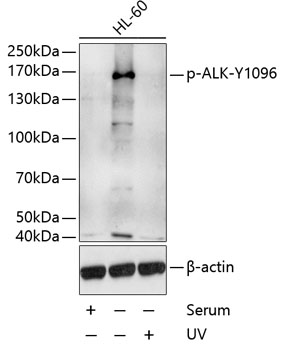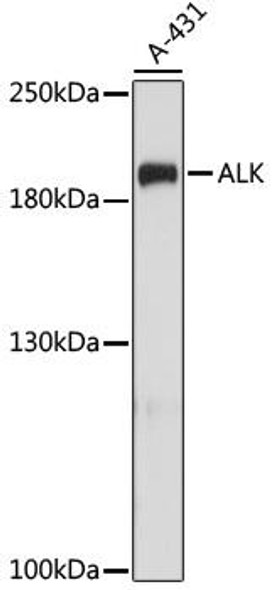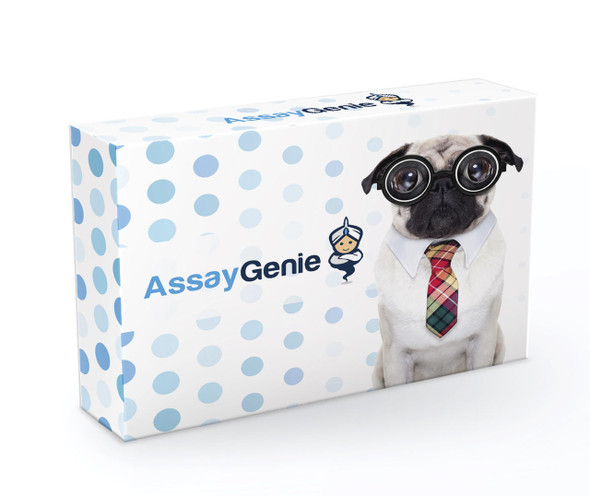Cell Biology Antibodies 16
Anti-Phospho-ALK-Y1096 Antibody (CABP0503)
- SKU:
- CABP0503
- Product Type:
- Antibody
- Applications:
- WB
- Reactivity:
- Human
- Host Species:
- Rabbit
- Isotype:
- IgG
- Research Area:
- Cell Biology
Description
| Antibody Name: | Anti-Phospho-ALK-Y1096 Antibody |
| Antibody SKU: | CABP0503 |
| Antibody Size: | 20uL, 50uL, 100uL |
| Application: | WB |
| Reactivity: | Human |
| Host Species: | Rabbit |
| Immunogen: | A synthetic phosphorylated peptide around Y1096 of human ALK (NP_004295.2). |
| Application: | WB |
| Recommended Dilution: | WB 1:500 - 1:2000 |
| Reactivity: | Human |
| Positive Samples: | HL-60 |
| Immunogen: | A synthetic phosphorylated peptide around Y1096 of human ALK (NP_004295.2). |
| Purification Method: | Affinity purification |
| Storage Buffer: | Store at -20°C. Avoid freeze / thaw cycles. Buffer: PBS with 0.02% sodium azide, 50% glycerol, pH7.3. |
| Isotype: | IgG |
| Sequence: | PNYC F |
| Gene ID: | 238 |
| Uniprot: | Q9UM73 |
| Cellular Location: | Cell membrane, Single-pass type I membrane protein |
| Calculated MW: | 176kDa |
| Observed MW: | 168kDa |
| Synonyms: | ALK, CD246, NBLST3 |
| Background: | This gene encodes a receptor tyrosine kinase, which belongs to the insulin receptor superfamily. This protein comprises an extracellular domain, an hydrophobic stretch corresponding to a single pass transmembrane region, and an intracellular kinase domain. It plays an important role in the development of the brain and exerts its effects on specific neurons in the nervous system. This gene has been found to be rearranged, mutated, or amplified in a series of tumours including anaplastic large cell lymphomas, neuroblastoma, and non-small cell lung cancer. The chromosomal rearrangements are the most common genetic alterations in this gene, which result in creation of multiple fusion genes in tumourigenesis, including ALK (chromosome 2)/EML4 (chromosome 2), ALK/RANBP2 (chromosome 2), ALK/ATIC (chromosome 2), ALK/TFG (chromosome 3), ALK/NPM1 (chromosome 5), ALK/SQSTM1 (chromosome 5), ALK/KIF5B (chromosome 10), ALK/CLTC (chromosome 17), ALK/TPM4 (chromosome 19), and ALK/MSN (chromosome X). |
| UniProt Protein Function: | ALK: a tyrosine kinase of the ALK family. Plays an important role in the development of the brain and exerts its effects on specific neurons in the nervous system. Translocated and expressed as a fusion protein in anaplastic lymphoma. About one third of large-cell lymphomas are caused by a t(2;5)(p23;q35) translocation that fuses ALK to nucleophosmin (NPM1A). Other cases caused by fusions of ALK to moesin, non-muscle myosin heavy chain 9, clathrin heavy chain and other genes. Several fusions also seen in inflammatory myofibroblastic tumors, and expression has been briefly noted in a range of tumors |
| UniProt Protein Details: | Protein type:EC 2.7.10.1; Protein kinase, TK; Membrane protein, integral; Kinase, protein; Protein kinase, tyrosine (receptor); Oncoprotein; TK group; Alk family Chromosomal Location of Human Ortholog: 2p23 Cellular Component: protein complex; integral to plasma membrane Molecular Function:NF-kappaB-inducing kinase activity; protein binding; protein-tyrosine kinase activity; transmembrane receptor protein tyrosine kinase activity; ATP binding Biological Process: regulation of apoptosis; cell proliferation; peptidyl-tyrosine phosphorylation; activation of MAPK activity; protein amino acid autophosphorylation; neuron development; signal transduction; phosphorylation; transmembrane receptor protein tyrosine kinase signaling pathway; activation of NF-kappaB transcription factor Disease: Neuroblastoma, Susceptibility To, 3 |
| NCBI Summary: | This gene encodes a receptor tyrosine kinase, which belongs to the insulin receptor superfamily. This protein comprises an extracellular domain, an hydrophobic stretch corresponding to a single pass transmembrane region, and an intracellular kinase domain. It plays an important role in the development of the brain and exerts its effects on specific neurons in the nervous system. This gene has been found to be rearranged, mutated, or amplified in a series of tumours including anaplastic large cell lymphomas, neuroblastoma, and non-small cell lung cancer. The chromosomal rearrangements are the most common genetic alterations in this gene, which result in creation of multiple fusion genes in tumourigenesis, including ALK (chromosome 2)/EML4 (chromosome 2), ALK/RANBP2 (chromosome 2), ALK/ATIC (chromosome 2), ALK/TFG (chromosome 3), ALK/NPM1 (chromosome 5), ALK/SQSTM1 (chromosome 5), ALK/KIF5B (chromosome 10), ALK/CLTC (chromosome 17), ALK/TPM4 (chromosome 19), and ALK/MSN (chromosome X).[provided by RefSeq, Jan 2011] |
| UniProt Code: | Q9UM73 |
| NCBI GenInfo Identifier: | 296439447 |
| NCBI Gene ID: | 238 |
| NCBI Accession: | Q9UM73.3 |
| UniProt Secondary Accession: | Q9UM73,Q4ZFX9, Q53QQ6, Q53RZ4, Q59FI3, Q9Y4K6, |
| UniProt Related Accession: | Q9UM73 |
| Molecular Weight: | 176,442 Da |
| NCBI Full Name: | ALK tyrosine kinase receptor |
| NCBI Synonym Full Names: | anaplastic lymphoma receptor tyrosine kinase |
| NCBI Official Symbol: | ALK |
| NCBI Official Synonym Symbols: | CD246; NBLST3 |
| NCBI Protein Information: | ALK tyrosine kinase receptor; CD246 antigen; mutant anaplastic lymphoma kinase |
| UniProt Protein Name: | ALK tyrosine kinase receptor |
| UniProt Synonym Protein Names: | Anaplastic lymphoma kinase |
| Protein Family: | ALK tyrosine kinase receptor |
| UniProt Gene Name: | ALK |
| UniProt Entry Name: | ALK_HUMAN |







